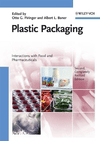Web exclusive
Packaging waste compliance legislation: the devil is in the detail
A risky business: food and beverage manufacturers are risking massive fines and reputational damage by failing to comply with European packaging waste compliance legislation.

In Europe, packaging waste compliance legislation is mature and robustly enforced, and the responsibility of European manufacturers is clearly defined by EU legislation. However, in the US, the manufacturer’s responsibility when selling products into the EU, may be less well understood.
The underlying principle of European waste compliance legislation is referred to as Extended Producer Responsibility (EPR). This applies to product packaging across its entire lifecycle and requires companies to ensure the recyclability of packaging and the use of recycled materials throughout the manufacturing and sales process. In Europe, EPR applies to the company placing the packaged product on the market - this could mean you as the manufacturer, or your distributors and retailers.
EU regulations ensure corporations have responsibility for their products’ packaging long after it has left the US manufacturing facility. If you have legal entities in the EU, you are obligated under the packaging waste directive to register with an accredited recycling organisation and to pay fees.
To make matters more complex, fees are calculated differently in every EU country, each with their own reporting cycle and documentation.
By not meeting the requirements of EPR legislation, US corporations are at risk of large-scale fines and significant reputational damage. Soft drinks giant Red Bull was harshly penalised in 2009 in the UK after admitting to a range of environmental breaches. The company was required to pay nearly half a million dollars in fines, plus their legal costs.
No brand is too beloved either to escape consumer wrath. Coffee giant Keurig, supplier to an estimated one in three American homes, recently discovered this when the lack of recyclability of the brand’s plastic pod packaging made headlines globally. Customers are now threatening to boycott the company until it makes its pods more environmentally friendly, which will certainly harm the brand’s reputation in the short term.
So, how best can you navigate compliance and ensure optimum sales to European markets? First, understand the detail and your specific compliance obligations – how are your products packaged? What quantities of your products are placed on the market, and in which European countries? This is key to understanding your level of obligation. There are companies which can calculate this for you, or provide software to ease and automate the compliance process.
In general, packaging fees are calculated on the tariff attributed to different types of packaging material (paper, plastic, glass etc.) multiplied by the sales within the specific country. Analysing your packaging may seem relatively straightforward, but countries frequently ask for different levels of detail. One may be satisfied with the description ‘plastic’, whereas another will want to know the type of plastic.
If you export to European countries, you may also choose to display the Green Dot (German: Der Grüne Punkt) on your packaging to demonstrate compliance. This trademarked logo indicates to consumers that you have paid fees to a national packaging recovery organisation.
There’s a need for US manufacturers to become more aware of the issues related to the end-of-life management of their products. Packaging waste regulations are implemented to make manufacturers consider the environmental impact of their packaging design to thus minimise the total amount of packaging in a bid to reduce waste and increase the use of recycled materials. The payback to manufacturers can be increased margins and reduced costs – ample rewards for investigating the devils behind the detail.
To find out more about Lorax Compliance, its software and its team, please visit: loraxcompliance.com.
Looking for a reprint of this article?
From high-res PDFs to custom plaques, order your copy today!









